9 September 1778 Wednesday
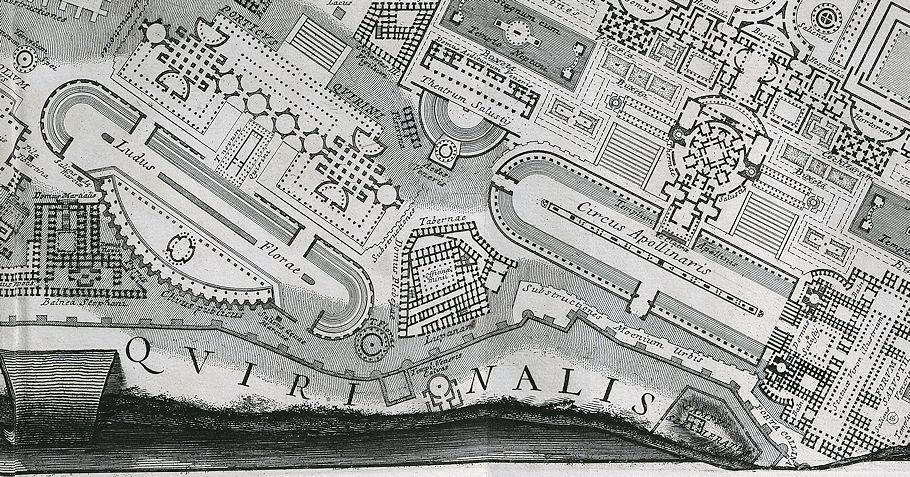
After fully erasing the Circus Apollinaris and its incorporated Templum Apollinis et Clatra, Laura asked her father if he had decided what to do about the Ludus Florae. Piranesi was still unsure of what to do with the Ludus Florae, so he told Laura her erasing was now done for the time being.
"I just don't know if it should be changed or not. I planned the Ludus Florae in that fashion because there was an ancient temple of Flora at the Circus Maximus, and Bufalini's plan of the Circus Maximus became the inspiration."
"Gosh, this whole plan is like a memory palace."
"Yes, that's exactly what it is."
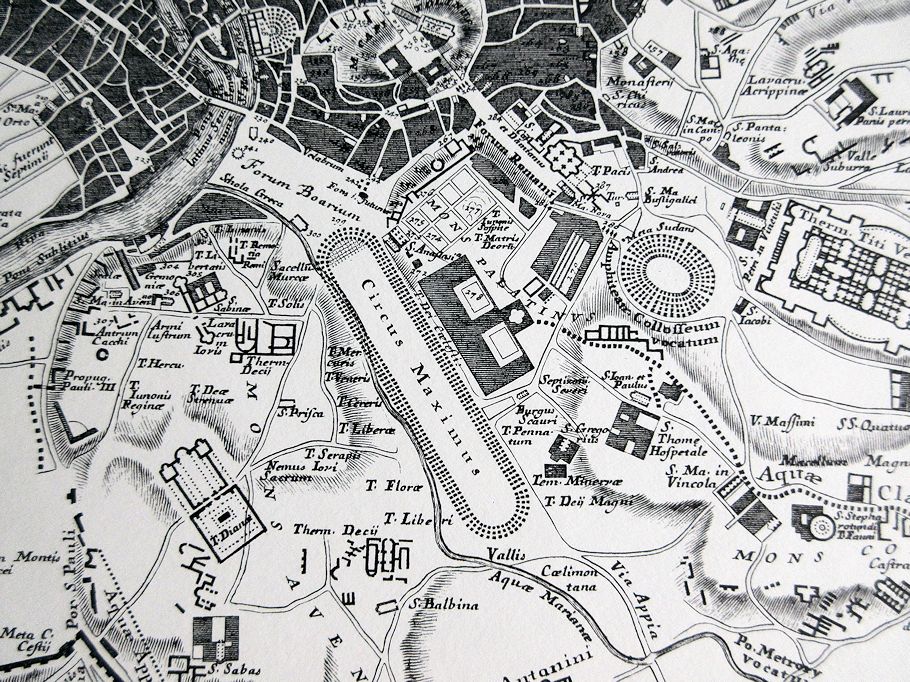
Artifacts of the Bianconi vs Piranesi 'Circus of Caracalla' affair 1772-1789
From: Pierre Pinon, Pierre-Adrien PÔris architecte (1745-1819) ou l'archÚologie malgrÚ soi (doctoral thesis: Volume III, PÔris et l'ArchÚologie, 1997), pp. 44-7:
Giovanni Battista Piranesi
PÔris probably got to know Piranesi upon his arrival in Rome as a boarder, the famous engraver frequenting the Mancini Palace, and the young boarders having long been inspired by his work.127
PÔris very often cites Piranesi in his various studies. Antique dealers did the same, his authority as an antiquarian being recognized.
But when PÔris quotes Piranesi, it is most of the time to criticize him. An expression, used by PÔris regarding the resumption by Piranesi of the plan restored by S. Serlio of the Quirinal temple, sums up his opinion: "Piranesi famous dreamer".128 After a period of admiration, it seems that from the 1770s, the attitude of young French architects towards Piranesi changed. Moreover, a little later, E.-L. BoullÚe, in his "Essay on Art", will use the same word: "I cannot imagine the productions of a fantastic art without representing to myself ideas thrown here and there, without sequence, without connections, without purpose, disorders of the mind, in a word, dreams. Piranesi, architect, engraver, has brought to light some similar follies."129
PÔris refers to Piranesi regarding several ancient monuments: - for the Colosseum: "After Desgodets, Piranesi the father is the author who can be advised with the most fruit on the current state of this amphitheater, where the We find the most positive indications on what could have existed as well as on the construction. The large view it gives of the interior, taken from the top of the inclined plane which supported the stands, on the south side, or the The arc of Constantine, is very precious for all the details it offers and for their accuracy: it is one of the last productions of this author."130 This is the most flattering text from PÔris for Piranesi.
- for the Pantheon: "We do not know how we should understand this passage. Some people, including Piranesi, believed that these cariathides were placed in the tabernacles as columns, which would have been very painful."131 - for the portico of Octavia: "Piranesi says that we found on the bases of these columns a frog and a lizard which were the monograms of Satire and Basatraco Greek architects who built in Rome at the end of the Republic and who used this means to pass on to posterity their name which they were not allowed to put on the frontispiece."132 "Piranesi says that we see on the plinth of the bases of these columns a frog and a lizard represented in low relief [...].133 "Their base being hidden in the cellar of an individual who does not want to allow access to it, I was unable to verify a very curious thing that Piranesi mentions and which relates to a singular feature of history."134
- for Hadrian's Villa, the restitution of PÔris refers to Piranesi's plan of 1781 (Fr. Piransesi, Planta delle fabriche esistenti nella Villa Adriana, Roma), but he also writes: "The oldest plan of this beautiful place was made by Pirro Ligorio and published by Francesco Contini. Towards the end of the last century J.-B. Piranesi, aided by this work, gave a new plan on a much larger scale. It is more exact than most of his other productions."135
PÔris this time expresses doubt about the veracity of Piranesi's statements. In another text he is even more explicit: "Piranesi was a good draftsman, made beautiful views, engraved them well as well as beautiful antique details, but he did not even have a touch of erudition or literature. was a Jesuit, the Father136 whom he paid to support his setbacks in any reasoning. I am not saying that he is absolutely wrong [Guattani says that Piranesi does not see in a room of the thermal baths of Caracalla a swimming pool which nevertheless is one] in that he asserts that the baths were underground; but I am inclined to believe that he is wrong. There are underground rooms at the baths of Titus produced by the substructions necessary to level the ground of the perimeter of the thermal baths built on the crest or on the edge [of Mount Esquiline]."137
Note that the opinion of PÔris expressed here on the incapacity of Piranesi to write works echoes that of Bianconi, with whom PÔris collaborated in 1773. "He [Piranesi] knew how to skillfully captivate certain distinguished scholars who, enamored of his genius and of his chisel, did not disdain to work for him, composing remarkable treatises which corresponded to such beautiful copperplates. They had the generosity to allow him to publish them under his name. Among this number we can count without hesitation Mgr Bottari, the learned P. Contucci, of the company of Jesus, and certain others whom we believe it is useless to name here. Rome thus saw the publication from time to time of atlases of prints accompanied by very learned dissertations, under the name of someone who was barely able to read them, although he could give an excellent account of them, but in his own way, when people spoke to him about them. [...] In the end, he came to persuade himself that these books were entirely his work, these books that so many illustrious pens had composed for him, and woe betide anyone who did not agree with him, without excluding the authors themselves!ö138
We can therefore imagine complex relationships between PÔris and Piranesi. Let us recall that the latter, around 1772-1774, had entrusted the education of his son Francesco to PÔris. We also know that these two lovers of antiquities exchanged information, and we have at least one proof of this regarding a cornice from the theater of Marcellus that PÔris found: "Piranesi himself, who went into details madmen on this monument, did not give it away. I communicated it to him by showing him where it was located and I have no doubt that he will add it to his work."139
We must therefore consider collaboration between architects, but not without a certain distrust, on the part of PÔris at least.
[47 y.o. Francesco Piranesi 1805]?
Le AntichitÓ della Magna Grecia Parte II
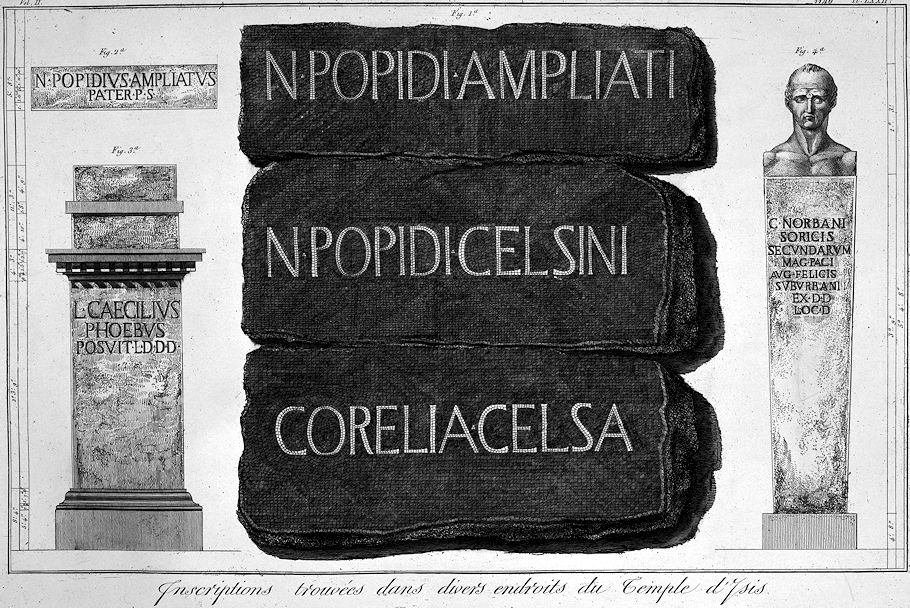
Inscriptions found in various places in the Temple of Isis.
[Drawn by G.B. Piranesi
Engraved by F. Piranesi Year 13 (1805)]?
9 September 1812 Wednesday
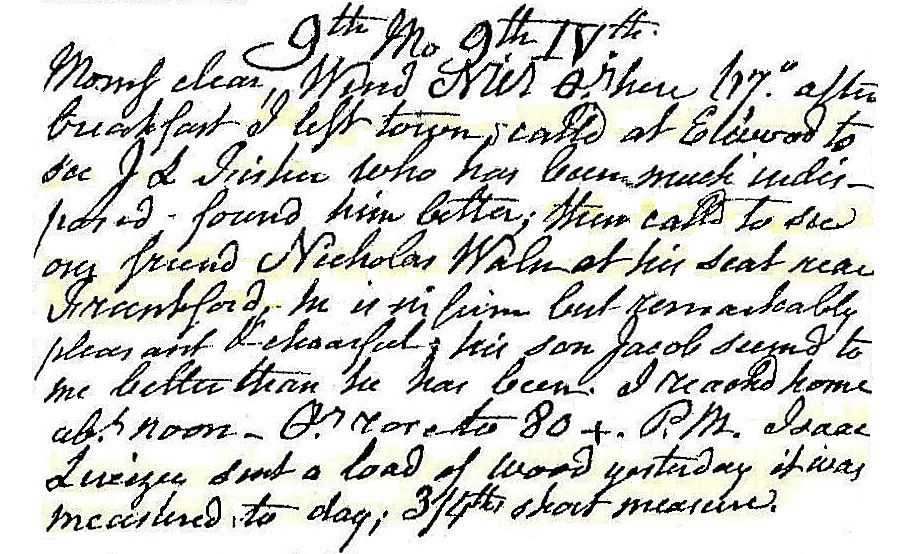
Morning clear, wind NW, temperature 67░. After breakfast I left town, called at Elwood to see JS Fisher who has been much indisposed--found him better; then called to see our friend Nicholas Waln at his seat near Frankford. He is infirm but remarkably pleasant and cheerful; his son Jacob seemed to me better than he had been. I reached home about noon. Temperature rose to 80+. PM Isaac Livezey sent a load of wood yesterday. It was measured today; 3/4th short measure.
9 September 2001
Re: architexturalizing
I suggest anyone interested in damnatio memoriae (a specific type of censorship) read History and Silence, by Charles W. Hedrick, Jr. (2000). Here are some of the chapter titles: "Remembering to Forget"; "Silence, Truth and Death"; "Rehabilitating the Text"; and "Silence and Authority".
In "Remembering to Forget" one learns that damnatio memoriae actually did more to make people remember than it did to make them forget. Officially and literally, the memory was erased, however, the act of erasure itself, like the scar that it is, only reinforces the real reality that once was. Yes, erasures ironically are very full of meaning...
9 September 2002
"Piranesi Police"
I wanted to mention a piece entitled "Piranesi Police" where I will write about a police station that Piranesi positioned within the Campo Marzio, which is next to a house of prostitution, next to one of the Sessorium, next to the 'sinuous' porticus around the small body of water reflecting the altar of Mars, which is indeed the first historical erection in the Campo Marzio (not counting when Mars raped a Vestal Virgin, of course).
9 September 2022
Saw the almost full Harvest Moon positioned nicely between Jupiter and Saturn in the southeast night sky.
9 September 2023 Saturday
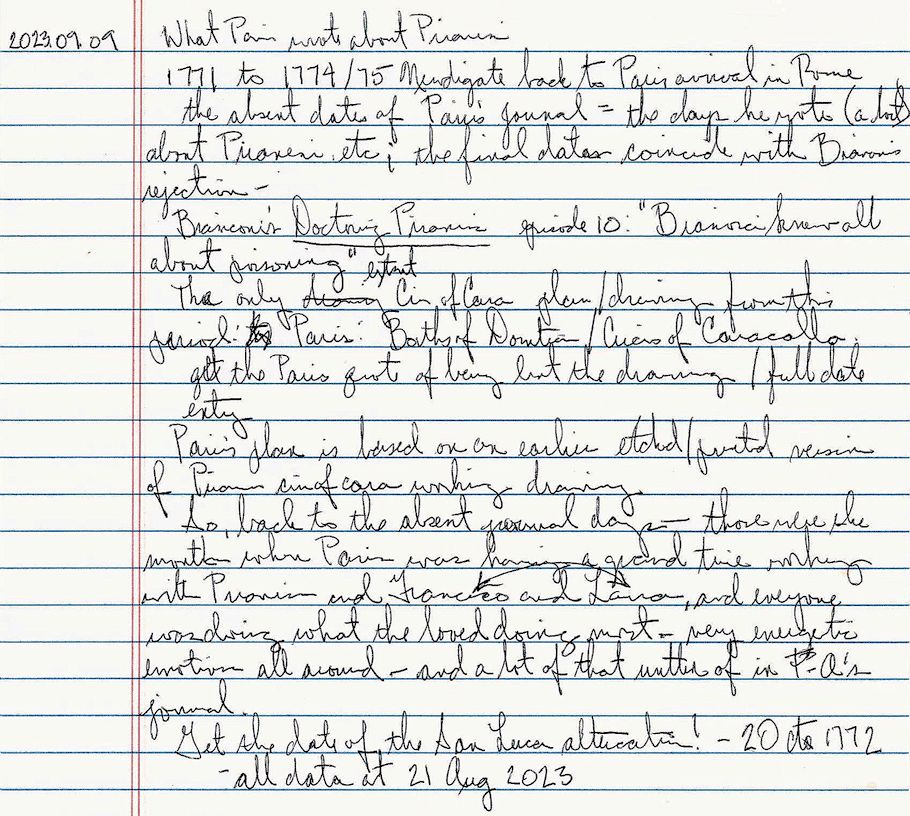
Bianconi's Doctoring Piranesi episode ten: "Dr. Bianconi knows all about poisoning, of course"
|